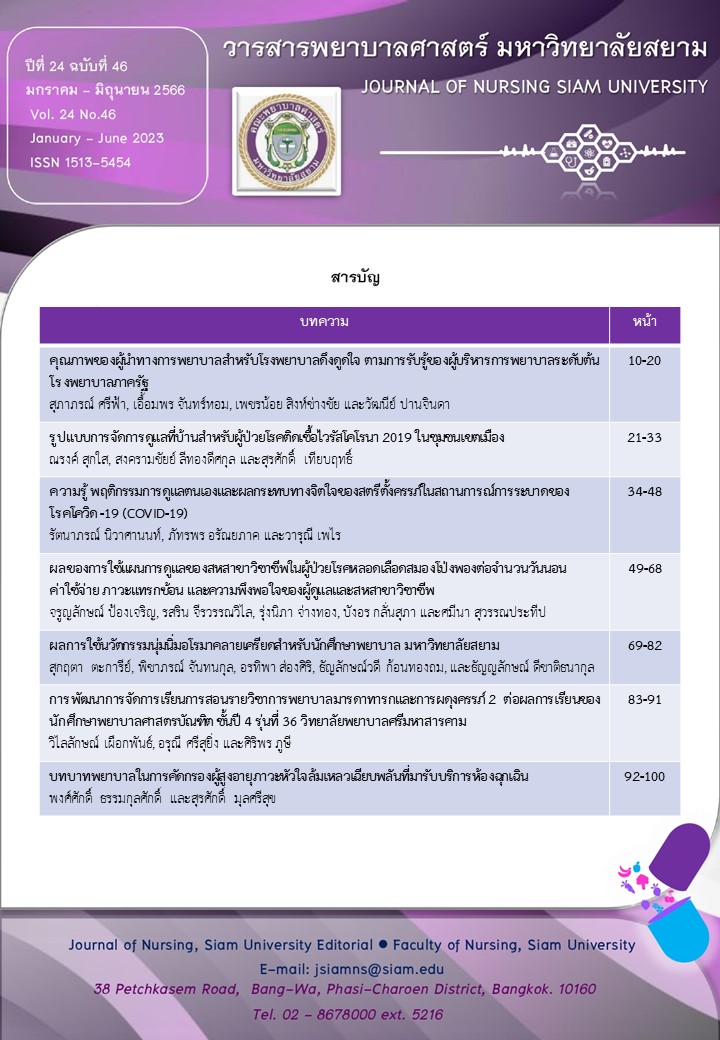The Result of Using Aroma Soft Doll Innovation to Relieve Stress for Nursing Students at Siam University
Keywords:
Aroma soft doll innovation, Nursing student, Relieve stressAbstract
The quasi-experimental research the objective was to study the effect of using The Result of using Aroma soft doll innovation to relieve stress for nursing students. In a group of 215 moderately stressed-highly stressed students, a controlled study was conducted. Measure the results before and after the experiment. It was divided into 108 experimental groups and 107 control groups. The experiment was conducted for 4 weeks in July-December 2022. Selye theory (1976) was applied as a research conceptual framework. The instruments used in the experiment were Aroma soft doll innovation developed by the researcher tools used to collect data consisted of a stress assessment form of the Department of Mental Health (SPST-20), a questionnaire on the use of Aroma soft doll innovation and the satisfaction questionnaire on the use of Aroma soft doll innovation had a validity of 0.85, 0.83, 0.86 and 0.83 with a reliability of 0.85, 0.78, 0.71, and 0.67, respectively. Descriptive data were analyzed using percentage, mean, and statistics. Standard deviation the results were compared with the t-test and the correlation was analyzed using Pearson's correlation coefficient.
The results showed that: The Result of using Aroma soft doll innovation to relieve stress for nursing students of the experimental group was significantly lower than the control group at 0.05. Factors that affected the stress of nursing students with statistical significance (p < 0.01) were family factors followed by economic factors theoretical study and relationship (p < 0.05).
References
กรมสุขภาพจิต โรงพยาบาลสวนสราญรมย์. 2563. คู่มือแบบประเมินคัดกรองโรคจิตและปัญหาสุขภาพจิต. สืบค้นจาก http://1.179.139.229/upload/2021-02-17-1010.pdf
ฉัตรมณี เจริญธนะรุ่งเรือง. (2561). การสร้างงานประติมากรรมร่วมกับการใช้แสงไฟเพื่อศึกษาการบำบัดโรคเครียดส่วนบุคคล. วิทยานิพนธ์หลักสูตรศิลปมหาบัณฑิต มหาวิทยาลัยศิลปากร.
นิศากร โพธิมาศ, สุนทรีภรณ์ มีพริ้ง, และมาลินี อยู่ใจเย็น. (2564). ความสัมพันธ์ระหว่างความเครียดในการเรียนออนไลน์ ความยืดหยุ่นทางอารมณ์และการเผชิญความเครียดของนิสิตพยาบาล ในช่วงการแพร่ระบาดของโควิด-19. วารสารวิจัยสุขภาพและการพยาบาล. 37(3), 142-152.
ปุณณรัตน์ พิชญไพบูลย์. (2561). จิตวิทยาศิลปะสุนทรียศาสตร์เชิงประจักษ์. พิมพ์ครั้งที่ 2 . โรงพิมพ์แห่งจุฬาลงกรณ์มหาวิทยาลัย.
ภัทรานิษฐ์ เหมาะทอง, วนิดา ทองโคตร, และสุพรรณี อึ้งปัญสัตวงศ์. (2560). การกำหนดขนาดตัวอย่างโดยใช้สูตรYamane (Determining the sample size by the Yamane’s formula.). สืบค้นจาก http://sc2.kku.ac.th/stat/statweb/images/Eventpic/60/Seminar/01_9_Yamane.pdf
สุกฤตา ตะการีย์, พิชาภรณ์ จันทนกุล, รัตนาภรณ์ นิวาศานนท์, กาญจนา งามจันทราทิพย์ และศิริพร สามสี.(2565). ผลลัพธ์การจัดการเรียนภาคปฏิบัติออนไลน์ในนักศึกษาพยาบาลช่วงสถานการณ์การแพร่ระบาดของเชื้อไวรัส โคโรนา 2019: กรณีศึกษารายวิชาปฏิบัติการพยาบาลรวบยอดสาขาผดุงครรภ์. วารสารพยาบาลศาสตร์ มหาวิทยาลัยสยาม. 23(45), 73-87.
สุรพจน์ วงศ์ใหญ่. (2543). นิยามของสุคนธบำบัด. ตำราวิชาการสุคนธบำบัด. กองการแพทย์ทางเลือก กรมพัฒนาการแพทย์แผนไทยและการแพทย์ทางเลือก. 1-7.
สิริทรัพย์ สีหะวงษ์, ณิชกานต์ ฝูงดี, ณัฐธิดา ยานะรมย์, ณัฐนรี น้อยนาง, ณัฐมล อาไนย์, ตุลาภรณ์ บุญเชิญ, ทริกา จอดนอก, ทัตติยา สุริสาร และธัญญาเรศ พ่อยันต์. (2561). ปัจจัยที่ส่งผลต่อความเครียดของนักศึกษาคณะพยาบาลศาสตร์ มหาวิทยาลัยอุบลราชธานี. วารสาร มฉก.วิชาการ. 21(42), 93-106.
สืบตระกูล ตันตลานุกุล, และปราโมทย์ วงศ์สวัสดิ์. (2561). ความเครียดและการจัดการความเครียดของนักศึกษาพยาบาล. วารสารวิทยาลัยพยาบาลบรมราชชนนี อุตรดิตถ์. 9(1), 81-90.
Best, John W. (1977). Research in Education. 3rd ed. Englewood Cliffs, New Jersey: Prentice Hall, Inc.
Selye. (1976). The stress of life. (Rev.ed). New York: McGraw Hill Book Co.
Downloads
Published
How to Cite
Issue
Section
License
Copyright (c) 2023 Journal of Nursing, Siam University

This work is licensed under a Creative Commons Attribution-NonCommercial-NoDerivatives 4.0 International License.
Content and information published in the Journal of Nursing, Siam University is the comment and responsibility of the authors.
Articles, information, images, etc. published in the Journal of Nursing. Siam University is the copyright of the Journal of Nursing, Siam University. If any person or entity wants to take all or part of it for publication for any purposes, please reference the Journal of Nursing, Siam University.



